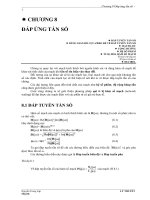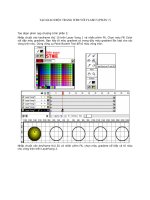GIÁO TRÌNH MARKETING NGHIÊN CỨU - PHẦN 7 doc
Bạn đang xem bản rút gọn của tài liệu. Xem và tải ngay bản đầy đủ của tài liệu tại đây (324.84 KB, 21 trang )
Standardized Information
Sources
Ch 7 2
What is Standardized
Information?
•
Standardized information is a type of
secondary data in which the data
collected and/or the process of
collecting the data are standardized
for all users.
•
Two broad classes:
–
Syndicated data
–
Standardized services
Ch 7 3
Types of Standardized
Information
•
Syndicated data are data that are
collected in a standard format and
made available to all subscribers.
–
Example: The Nielsen TV Ratings
Ch 7 4
Types of Standardized
Information
•
Standardized services refers to a
standardized marketing research
process that is used to generate
information for a particular user.
–
ESRI’s
Community
Tapestry
Ch 7 5
Advantages of Syndicated Data
•
Advantages:
–
Shared costs
–
Quality of the data collected is typically
very high.
–
Data are normally disseminated very
quickly.
Ch 7 6
Disadvantages of Syndicated
Data
•
Disadvantages:
–
Buyers have little control over what
information is collected.
–
Firms often must commit to long-
term contracts.
–
No strategic information advantage
in purchasing syndicated data.
Ch 7 7
Advantages of Standardized
Services
•
Advantages:
–
Taking advantage of the
experience of the research firm
offering the service.
–
Reduced cost.
–
Speed of the research service.
Ch 7 8
Disadvantages of Standardized
Services
•
Disadvantages:
–
The ability to customize some
projects is lost.
–
The company providing the
standardized service may not know
a particular industry well.
Ch 7 9
Application Areas of
Standardized Information
•
Measuring Consumer Attitudes and
Opinion Polls
–
Yankelovich Monitor
–
Harris Poll
–
Gallup Poll
•
Defining Market Segments
–
Dun’s Market Identifiers (DMI) for
b2b
–
Vals
Ch 7 10
Examples
Gallup.com
•
Public opinion polling
•
Wide variety of topics: Iraq, military &
defense, stem cell research,
important factors in buying a car,
smoking population percents over
time, guns, etc.
•
Some issues may be tracked over
several years; Gallup started in 1935.
•
/> Ch 7 11
Examples
Dun’s Market Identifiers
•
Dun & Bradstreet credit bureau
collects vast amount of information
on business firms, private and public.
•
4 million firms in data base updated
monthly
•
Whereas SIC uses 4 digits and
NAICS uses 5 or 6, DMI’s uses 8
digits to classify firms into very
specific types of businesses.
Ch 7 12
Examples
Dun’s Market Identifiers
•
Manufacturer of wooden gift baskets
•
Small without marketing resources
•
Needed wholesalers…of gift baskets.
Where are they? Who are they?
•
SIC: 51 Code for
wholesalers/nondurables
•
5199, wholesalers, nondurables,
miscellaneous goods! Thousands of
firms wholesaling all kinds of goods.
•
51990603 DMI code: wholesalers of
gift baskets. 45 in U.S. Complete
info on each!
Ch 7 13
Geodemographics
•
Geodemographics is the term used to
describe the classification of
arbitrary, usually small, geographic
areas in terms of the characteristics
of their inhabitants.
Ch 7 14
Geodemographics
•
Claritas has a market profiling system
called PRIZM.
–
Defines every neighborhood in the
U.S. in terms of 66 different
clusters.
–
ESRI’s Community Tapestry; 65
segments
–
Donofrio’s Coffee Example at
beginning of chapter, p. 177 ff.
Ch 7 15
Application Areas of
Standardized Information (cont.)
•
Conducting Marketing Tracking:
RETAIL, HOME
–
Market tracking studies monitor, or
track, a variable over time.
•
ACNielsen’s Scantrack®
Services
4,800 food, drug and mass
merch weekly!
Ch 7 16
Application Areas of
Standardized Information (cont.)
–
Market tracking studies monitor, or
track, a variable over time.
•
ACNielsen also has
Convenience Track® for tracking
products sold through c-stores
•
Infoscan’s Custom Store
Tracking
32,000 supermarkets, drugstores,
and mass merch. –weekly
HOUSEHOLD DATA are collected
through panels
Ch 7 17
•
A problem with today’s IT
environment is information overload.
There is a need to help managers
trying to digest thousands of pages of
scanning data. How do you turn
tracking data into intelligence?
•
Research firms designed
standardized services to help…
–
IRI’s Builder
–
AC Nielsen’s category Business
Planner (next slide)
Ch 7 18
ACNielsen’s Category Business
Planner
•
Allows manufacturers to see how
their products are performing within
each retailer’s own proprietary
planning process
Ch 7 19
Application Areas of
Standardized Information (cont.)
•
Monitoring Media Usage and Promotion
Effectiveness
–
Tracking downloaded music –
ACNielsen’s SoundScan
–
Television – Nielsen Television Index
(NTI)
Ch 7 20
Application Areas of
Standardized Information (cont.)
•
Monitoring Media Usage and Promotion
Effectiveness
–
Radio – Arbitron
–
Print – NOPWorld’s
Starch Readership
Service
–
Multimedia – Simmons
National Consumer Study
Ch 7 21
Single Source Data
•
Single-source data: data that contain
information on several variables such
as promotional message exposure,
demographics, and buyer behavior.
–
Recorded continuously from a panel of
respondents to measure their exposure to
promotional materials (usually TV as well as
in-store promotions) and subsequent buying
behavior
–
Can help managers determine causal
relationships between types of promotions and
sales.
•
Example: BehaviorScan
Age Income TV ad? Purcha
se?
Old Low No No
Young High Yes Yes
Young Modera
te
Yes Yes









